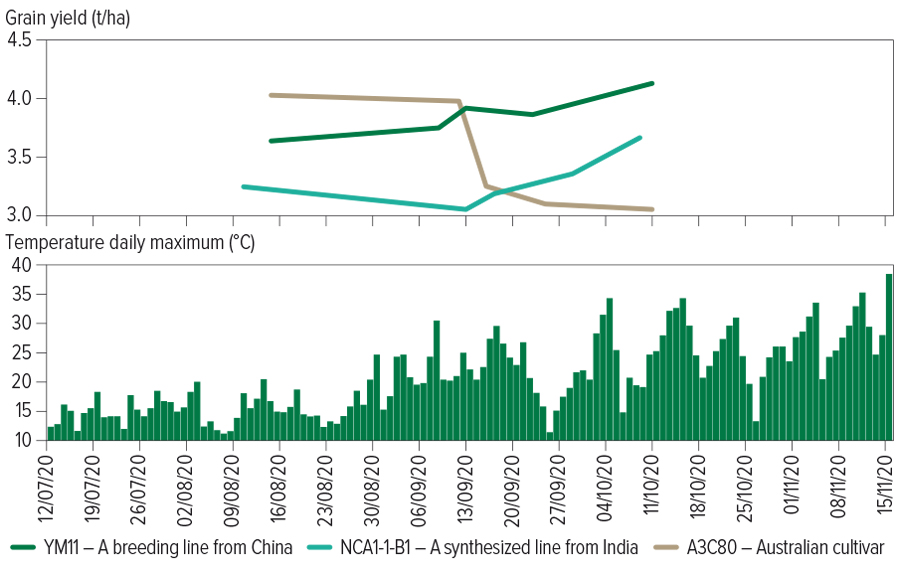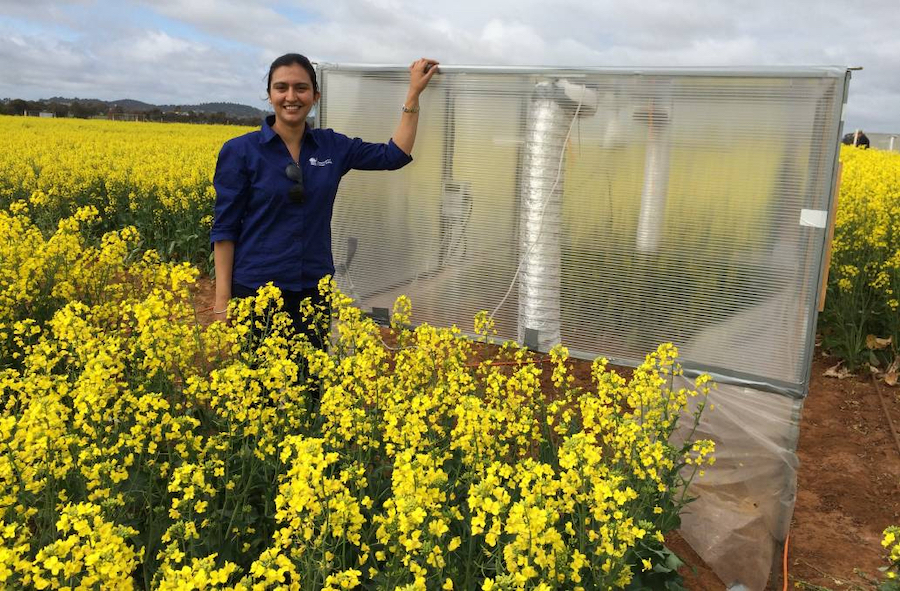Novel genetic solutions to heat-induced yield losses in canola are proving possible following multi-year and multi-site trials across Australia using germplasm specifically created to introduce novel diversity into the canola gene pool.
Heatwaves (where daily maximum temperatures exceed 30°C for one or more days) are becoming more common in Australia during spring, when canola crops are in their peak flowering period. Flowers affected by heatwaves commonly fall off the plant. If they remain on the plant, the pods have few viable seeds, which results in significant yield losses.
Tolerance to such heatwaves has been found in new diverse germplasm and confirmed to be effective during the flowering phase in field trials across southern Australia. Tolerant varieties were able to recover from heatwaves by producing more pods and more seeds on side branches.
In several notable lines, this novel tolerance mechanism not only reversed the heat-induced yield losses seen in Australian cultivars, but also allowed the new lines to yield very well in late-sown plots that experienced a series of heatwaves (see Figure 1).
Figure 1: Yield data from heat-stress field trials that included two new canola lines (YM11 and NCA1-1-B1) that display heat tolerance.

Source: CSIRO
These findings are the result of GRDC investment since 2019 in a national project led by Dr Sheng Chen at the University of Western Australia (UWA) with an eastern node led by Dr Rajneet Uppal at the New South Wales Department of Primary Industries (DPI). The project is supported by the western node of Statistics for the Australian Grains Industry (SAGI), which assists with field trial design and data analysis.
Canola reimagined
The heat tolerance breakthrough was made possible by a previous, ambitious project that successfully widened the genetic diversity of canola germplasm available to breeders and pre-breeders. This essential preliminary work was undertaken by an international team that included Dr Chen.

Dr Rajneet Uppal testing portable heat chambers in the field at NSW DPI. Photo: NSW DPI
The international team selected canola-quality progeny from crosses with species related to canola that contained genetic diversity not currently found in the cultivated gene pool. That project too was the result of GRDC investment (UM00045) and was undertaken in partnership with scientists in India and China.
Preliminary testing of the new, resynthesised canola indicated that the approach had succeeded in making available novel forms of heat tolerance and disease resistance.
Dr Chen’s latest project set out to phenotype and characterise the novel heat tolerance traits and make them available to Australian canola breeders, along with DNA markers to aid in the selection of the underlying gene networks.
From controlled environment trials to field trials
Dr Chen and Dr Uppal have established a three-tiered approach to sort through the new germplasm that capitalises on expertise at UWA and DPI.
The bulk of the material (more than 300 lines) was first tested in a prototype heat screening facility developed at UWA. The heat screening facility simulates heatwaves using chambers that raise the temperature to about 32°C for four hours, starting at 11am before gradually decreasing to 22°C overnight.
In all, the canola lines were tested for eight agronomic traits, of which five traits were stem-based (such as seed yield on main stem) and three related to the whole of the plant (such as total seed yield).

The Heat Screening Facility developed at the University of Western Australia. Photo: UWA
The best-performing material then graduated to the second tier of testing, which required portable field heat chambers at NSW DPI managed by Dr Uppal that guarantee heat stress over field plots during flowering.
The third tier of testing included the most promising material, which underwent extensive field testing over four years at up to four sites across southern Australia. These sites were:
- Dongara, Western Australia (350 kilometres north-west of Perth);
- Leeton, NSW (Riverina region);
- Narrabri or Condobolin (in the heat-prone region of northern NSW); and
- Kerang (near the Loddon River in northern Victoria).
To ensure that the germplasm experienced heat stress at flowering, sowing was staggered over five planting dates. The early dates of sowing did not experience heat stress at flowering, while the later sowings were more likely to experience heatwaves at flowering.
Three years of field trials have been completed, with the final trial underway in 2023. To ensure that drought stress did not interfere with the heat tolerance assessment, irrigation was used at the various sites.
Findings
Dr Chen used data from the heat screening facility to calculate the percentage change (PC) in seed production between heat stress and control treatments. He also calculated a stress tolerance index (STI). Both PC and STI were used to rank the germplasm for heat stress tolerance.
Dr Chen identified 42 lines with outstanding PC and STI scores, with the top eight lines consistently performing well in early and late sowing conditions.
Meanwhile, Dr Uppal confirmed the best-performing material also performed well in the portable heat chambers in the field at NSW DPI.
Finally, the field trials confirmed that the selected material performed well under paddock conditions, especially in late sowing times when heat stress occurred during flowering.
Two of these are YM11, a Chinese breeding line, and NCA 1-1B1 from India. Yields for these lines are shown in Figure where each dot represents a different sowing time. The later-sown plots experienced a series of heatwaves during flowering (see the temperature graph in Figure 1).
Strikingly, the late-sown YM11 plots – that experienced the highest temperatures during flowering – yielded 4.1 tonnes per hectare, which amounts to a 14 per cent yield increase on the earliest sown replicates. A similar post-stress increase in yield was also observed with resynthesised line NCA 1-1B1. In contrast, an Australian cultivar called 43C80 produced a 25 per cent yield loss in the later sowing dates when flowering occurred during heat stress (Figure 1).
“The findings support the conclusion that we have found useful heat tolerance traits within the new diverse canola lines,” Dr Chen says.
“The stress tolerance traits gave consistent results through three levels of tiered testing, from controlled-environment trials in the heat screening facility at UWA, to portable heat chambers at NSW DPI, through to paddock-scale testing in national field trials. This raises our confidence that we are detecting true heat tolerance traits.”
Genetic analysis
Dr Chen is now evaluating the lines in genome-wide association studies to identify DNA regions and DNA markers associated with inheritance of heat tolerance.
So far, he has identified 334 candidate genes with the potential to mediate heat tolerance. About 27 of these genes function to mitigate cellular damage caused by heat stress (heat shock genes). Many other genes are capable of relaying signals that change plant physiology that could be important to cope with heat stress.
The genome-wide single nucleotide polymorphism (SNP) markers used in the genetic analysis are able to detect subtle differences in the DNA sequences of these genes across tolerant and susceptible lines. A total of 14 such SNP markers have been identified so far that can select for significant improvements in heat stress tolerance (as reflected by the seed yield on main stem).
“The genes we are detecting tend to have minor heat tolerance effects individually and will need to be used in combination when developing tolerant cultivars,” Dr Chen says.
“Further testing will be needed to identify the smallest number of gene variants needed to give the biggest boost to heat tolerance so that markers and germplasm can be provided to canola breeders.”
This final step will make use of genomic selection technology to identify breeding values for heat tolerance and optimum breeding strategies for use by breeders.
Throughout this development work, Dr Chen and Dr Uppal have held open days at UWA and NSW DPI to display their research to canola breeders and researchers. Growers were also invited to view the new canola material at field trial sites.
“At the end of the project our aim is straightforward,” Dr Chen says. “We want to hand over germplasm that contains novel and useful levels of heat tolerance along with the markers and breeding strategies to best select for tolerance during breeding.”
More information: Sheng Chen, sheng.chen@uwa.edu.au

























































